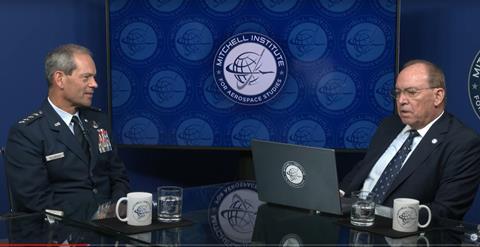The US Air Force (USAF) is focused on creating “dilemmas” to deter China, as it continues to work on new combat aircraft as well as upgrades to existing assets.
In a wide-ranging interview with the Mitchell Institute think tank, the commander of the USAF’s Air Combat Command, General Kenneth Wilsbach, stressed that the Next Generation Air Dominance (NGAD) programme is not an individual aircraft, but a family of systems.

“Everybody wants to talk about NGAD as a jet,” says Wilsbach. “It’s not a jet. It’s a family of systems… I just want everybody to be clear that it’s a family of systems, and there are a lot of things that are not in the public sphere that we’ve been working on for a while, and we’ll continue to expand that.”
One element in the public domain is the concept of Collaborative Combat Aircraft (CCA). Wilsbach suggests these could be produced in their thousands as part of the USAF’s efforts to “create dilemmas” for adversaries, namely China.
On a pilot’s ability to control a team of autonomous CCAs, he says that automation makes this far simpler. Wilsbach – who has flown the Boeing F-15C, Lockheed Martin F-16C and F-22A – recounts sitting down in the simulator of an aircraft in which he is not qualified. Within minutes he was able to fly his aircraft and comfortably direct CCAs to perform missions.
He believes that for opponents, the prospect of taking on thousands of USAF CCAs in addition to its manned assets will be extremely daunting.
Wilsbach expects a downselect on the NGAD programme to take place this year. Boeing and Lockheed are seen as prime candidates.
Wilsbach also touched on existing types. He believes that the extensive weapons carrying capability of the new F-15EX – which recently achieved initial operational capability – are extremely valuable. He feels the F-15EX will eventually be a key contributor to the long-range kill chains necessary to counter China.
Meanwhile, the USAF’s F-16s are getting new active electronically scanned array radars, which will allow them to pick up smaller targets at greater distances, as well as a new electronic warfare suite.
“The fleet that we have right now is in pretty good shape,” he says.
Wilsbach adds that the F-22 is undergoing upgrade work, and that he is inclined to keep the older F-22 Block 20s in service. The USAF has proposed retiring the Block 20s – as opposed to upgrading them to the Block 35 standard – on account of cost. The service uses them for training purposes now.
“I’m in favour of keeping the Block 20s,” says Wilsbach. “They give us a lot of training value, and even in an emergency if we had to use the Block 20s in a combat situation, they’re very capable.”
During the interview, Wilsbach stressed the need for the USAF to create dilemmas for potential opponents. One key area of work is freeing the USAF from big, easily hit bases through the Agile Combat Employment (ACE) concept. ACE makes USAF units harder to hit on the ground because it sees them deploying and moving around a range of airfields.
“We need to continue to get better and better at ACE,” he says.
Given that logistics can be challenging for aircraft shifting around island airfields in a contested environment, such as in the Western Pacific, the USAF has been pre-positioning things such as fuel, weapons and parts, and will continue to do so. Manpower can also be in short supply in austere locations, so the USAF is training airmen to be able to perform multiple jobs.
Wilsbach adds that China has conducted a massive military build-up and could resort to violence to take Taiwan.
“We in Air Combat Command would like to develop some dilemmas so that every day Xi Jinping wakes up and says ‘Not today, Not today’.”


























